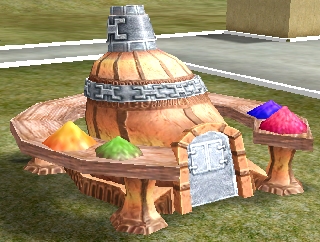The Wiki for Tale 7 is in read-only mode and is available for archival and reference purposes only. Please visit the current Tale 11 Wiki in the meantime.
If you have any issues with this Wiki, please post in #wiki-editing on Discord or contact Brad in-game.
Portable Star Lab
| English | Deutsch | français | magyar | Türkçe |

| |
|---|---|
| Size | N/A |
| Where | Outside |
Source
Portable Star Labs are the method by which new Stars may be discovered, for use in the Test of Pyrotechnics. Each university starts with the same two basic recipes, and can gain additional ones using Star Labs.
Each University of Art and Music distributes approximately two Portable Star Labs to players per week, apparently at random intervals. After use, a lab can be turned in at any University that has opened Pyrotechnics (note: not necessarily the one from which it was received).
Once a single university has received seven labs, the scientists there, also known as a random number generator, will select one of the seven submitted stars, and players will then be able to learn that recipe from that university, and only that university.
Please Note: By submitting the Star Labs at the SAME university, more recipes will be unlocked faster than by submitting them at different universities. Old Egypt has the closest UArt to the Chariot Stop, so it would make sense for that one to be used. It makes no difference, in the scheme of things, to have all the stars at a single university, so please think about this before you submit a Star Lab.
Use
Star labs are pre-loaded with materials to fire 60 shots. After each shot, the owner is given the option of:
- naming the shot that was just fired,
- selecting the shot that was just fired as the best so far,
- refiring the last shot without changing it,
- or firing a new random shot.
Players other than the owner can register as watchers of the display, and will be able to see the stars as they are launched, and read the costs of the most recently-launched star. The owner of the lab has sole discretion over which star is selected as the "best" - it is not a voting process - but typically the owners solicit input from the watchers and make a collaborative decision.
Once a final decision has been made and named, the lab can be turned in at a university. At this point, the number of watchers becomes important: this number is a weighting factor on how likely it is that that particular star design will be selected, once 7 total have been turned in. (Example: six labs are turned in with 1 watcher, and a seventh is turned in with 14 watchers. There will be a 70% chance that the seventh lab is the one selected)
Note: Make sure you don't leave the nomination of a favourite until the end, one cannot go back and you risk losing your star lab. Any favourite nomination is overwritten by a new favourite, so you can nominate the first one that looks half decent and then nominate a new one if you get a better one later
- There is no known game benefit to having or using a star lab, outside of its intended purpose of returning it to a university. Please don't keep them.
Required By
University of Art and Music
Types of Stars & Cost
Star labs seem to produce several basic kinds of stars: Pulsing, Cone, Bomb, Trails, and Sparkler.
See Stars for list of known Stars, Costs and University Locations.
Notes
- Turning in one lab is independent of the university producing another lab (e.g. it is possible for a university to produce a second lab before the first is turned in, or even before the first is requested by a player, but the latter seems quite unlikely)